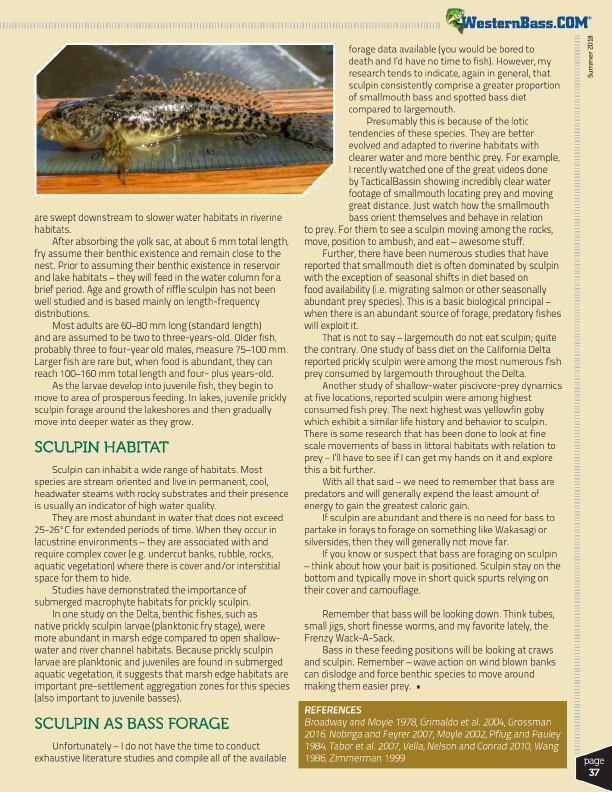
®
are swept downstream to slower water habitats in riverine habitats.
After absorbing the yolk sac, at about 6 mm total length, fry assume their benthic existence and remain close to the nest. Prior to assuming their benthic existence in reservoir and lake habitats – they will feed in the water column for a brief period. Age and growth of riffle sculpin has not been well studied and is based mainly on length-frequency distributions.
Most adults are 60–80 mm long (standard length) and are assumed to be two to three-years-old. Older fish, probably three to four-year old males, measure 75–100 mm. Larger fish are rare but, when food is abundant, they can reach 100–160 mm total length and four- plus years-old.
As the larvae develop into juvenile fish, they begin to move to area of prosperous feeding. In lakes, juvenile prickly sculpin forage around the lakeshores and then gradually move into deeper water as they grow.
SCULPIN HABITAT
Sculpin can inhabit a wide range of habitats. Most species are stream oriented and live in permanent, cool, headwater steams with rocky substrates and their presence is usually an indicator of high water quality.
They are most abundant in water that does not exceed 25-26°C for extended periods of time. When they occur in lacustrine environments – they are associated with and require complex cover (e.g. undercut banks, rubble, rocks, aquatic vegetation) where there is cover and/or interstitial space for them to hide.
Studies have demonstrated the importance of submerged macrophyte habitats for prickly sculpin.
In one study on the Delta, benthic fishes, such as native prickly sculpin larvae (planktonic fry stage), were more abundant in marsh edge compared to open shallow- water and river channel habitats. Because prickly sculpin larvae are planktonic and juveniles are found in submerged aquatic vegetation, it suggests that marsh edge habitats are important pre-settlement aggregation zones for this species (also important to juvenile basses).
SCULPIN AS BASS FORAGE
Unfortunately – I do not have the time to conduct exhaustive literature studies and compile all of the available
forage data available (you would be bored to
death and I’d have no time to fish). However, my
research tends to indicate, again in general, that
sculpin consistently comprise a greater proportion
of smallmouth bass and spotted bass diet
compared to largemouth.
Presumably this is because of the lotic
tendencies of these species. They are better
evolved and adapted to riverine habitats with
clearer water and more benthic prey. For example,
I recently watched one of the great videos done
by TacticalBassin showing incredibly clear water
footage of smallmouth locating prey and moving
great distance. Just watch how the smallmouth
bass orient themselves and behave in relation to prey. For them to see a sculpin moving among the rocks, move, position to ambush, and eat – awesome stuff.
Further, there have been numerous studies that have reported that smallmouth diet is often dominated by sculpin with the exception of seasonal shifts in diet based on food availability (i.e. migrating salmon or other seasonally abundant prey species). This is a basic biological principal – when there is an abundant source of forage, predatory fishes will exploit it.
That is not to say – largemouth do not eat sculpin; quite the contrary. One study of bass diet on the California Delta reported prickly sculpin were among the most numerous fish prey consumed by largemouth throughout the Delta.
Another study of shallow-water piscivore-prey dynamics at five locations, reported sculpin were among highest consumed fish prey. The next highest was yellowfin goby which exhibit a similar life history and behavior to sculpin. There is some research that has been done to look at fine scale movements of bass in littoral habitats with relation to prey – I’ll have to see if I can get my hands on it and explore this a bit further.
With all that said – we need to remember that bass are predators and will generally expend the least amount of energy to gain the greatest caloric gain.
If sculpin are abundant and there is no need for bass to partake in forays to forage on something like Wakasagi or silversides, then they will generally not move far.
If you know or suspect that bass are foraging on sculpin – think about how your bait is positioned. Sculpin stay on the bottom and typically move in short quick spurts relying on their cover and camouflage.
Remember that bass will be looking down. Think tubes, small jigs, short finesse worms, and my favorite lately, the Frenzy Wack-A-Sack.
Bass in these feeding positions will be looking at craws and sculpin. Remember – wave action on wind blown banks can dislodge and force benthic species to move around making them easier prey. •
REFERENCES Broadway and Moyle 1978, Grimaldo et al. 2004, Grossman 2016, Nobriga and Feyrer 2007, Moyle 2002, Pflug and Pauley 1984, Tabor et al. 2007, Vella, Nelson and Conrad 2010, Wang 1986, Zimmerman 1999
Summer 2018
page
37